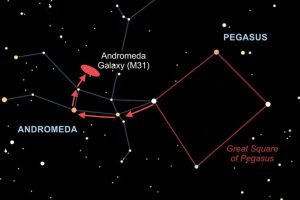Keith Wilson has had a lifelong interest in the night sky and has written for space and astronomy publications in the UK and USA. He lives under the dark night skies of the Isle of Gigha.
By Keith Wilson
It is 2.5 million light years from Earth and it is the most distant object most of us humans can see with the unaided eye.
The object in question is the Andromeda galaxy and you can see it at its best this month.
Ancient humans would have noticed it but the first known report came in the year 964 when the Persian astronomer Abd al-Rahman al-Sufi described the galaxy as a ‘small cloud’.
The Andromeda galaxy is the bigger twin of our Milky Way galaxy. Both are spiral galaxies which look like spinning Catherine wheels from above.
Andromeda is also known as M31 as it was the 31st on a famous list of fuzzy objects compiled by astronomer Charles Messier.
In early October, the Andromeda galaxy shines in our eastern sky at darkness, then swings high overhead in the middle of the night and ends up high in the west at dawn.
If you are stargazing during a moonless night, well away from lights, it is likely you will notice the galaxy up there in the Kintyre night sky. But if you don’t manage to easily see it, you can star-hop to find the galaxy.
Find the Great Square of Pegasus – see the September 1 issue of the Campbeltown Courier – and locate the far left star of the square. Hop two stars left, then hop in a right angle up to another star.

Once you are there, move up again and slightly right, a little less than the same distance, and you should see the galaxy which will appear as a smudge to the naked eye. Binoculars or a telescope will show more details.
Andromeda is one of three large galaxies in our corner of the universe and it is moving towards us at 112km every second. Astronomers have discovered it will eventually merge with our own Milky Way galaxy, but don’t worry, we will be safe for another four billion years.
Also, because there is more space than stars in a galaxy, the merge will be more like ghosts passing in the night. The two galaxies will likely change shape due to gravity and perhaps form a single much larger galaxy.
I mentioned above that the Andromeda galaxy is 2.5 million light years distant. So why do we measure distance in years when we talk about the universe? The universe is so big that measuring distances in miles or kilometers isn’t really practical because of the huge numbers involved.
It is much simpler to measure the distances of stars and galaxies in the time it takes for light to travel that distance. One light year is 10 trillion kilometres so when you spot the Andromeda galaxy in the night sky, you will know you are looking very, very far into the universe.